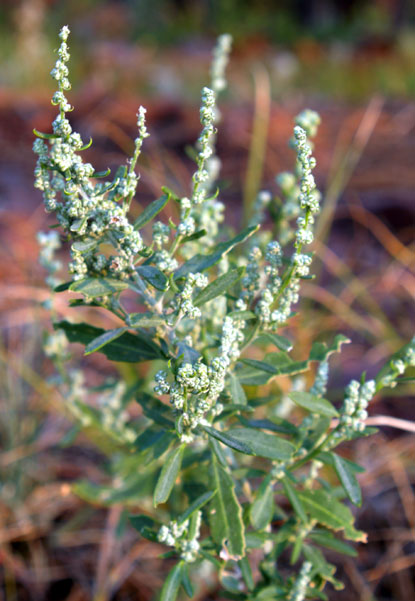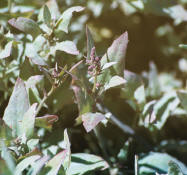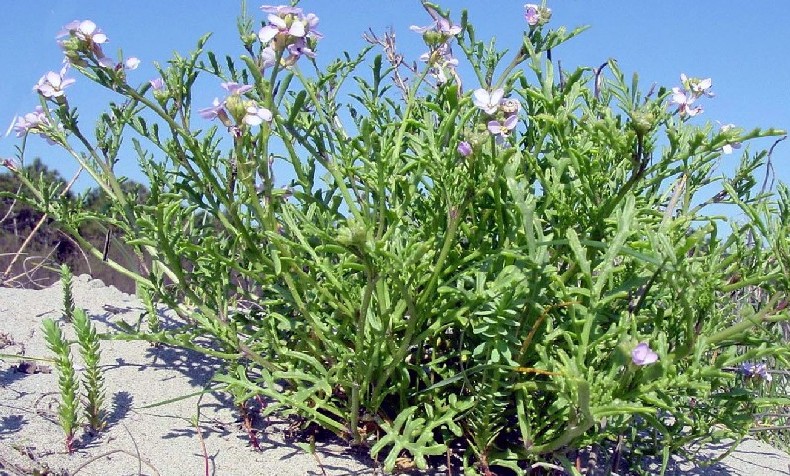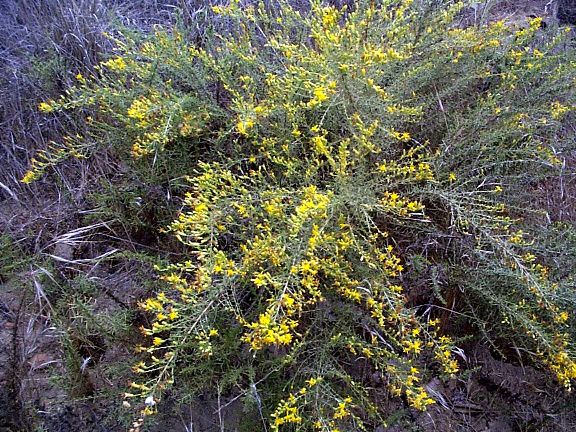Horned or annual sea-blite (suaeda depressa, variety erecta or suaeda calceoliformis)
B (only seen by Gustafson)
http://images.google.com/images?svnum=10&hl=en&lr=&q=suaeda+depressa
Published by the Ballona Ecosystem Education Project
Horned or annual sea-blite (suaeda depressa, variety erecta or suaeda calceoliformis)
B (only seen by Gustafson)
http://images.google.com/images?svnum=10&hl=en&lr=&q=suaeda+depressa
Woolly sea-blite (suaeda taxifolia also called Californica, variety pubescens)
B, C
http://images.google.com/images?svnum=10&hl=en&lr=&q=suaeda+taxifolia+

Sea-blite (suaeda esteroa)
Listed in Existing Conditions study
http://images.google.com/images?svnum=10&hl=en&lr=&q=suaeda+esteroa&btnG=Search
Parish’s pickleweed or samphire, (Salicornia subterminalis or arthrocnemum subterminale)
B
http://images.google.com/images?svnum=10&hl=en&lr=&q=salicornia+subterminalis

A,B,C, D
http://images.google.com/images?svnum=10&hl=en&lr=&q=salicornia+virginica
Annual pickleweed (salicornia bigelovii)
Listed in Existing Conditions study
http://images.google.com/images?svnum=10&hl=en&lr=&q=salicornia+bigelovii&btnG=Search
netseed lamb's quarters, chenopodium berlandieri, variety sinuatum
B, C , D
http://images.google.com/images?svnum=10&hl=en&lr=&q=chenopodium+berlandieri

| NPS Photo by Jim Pisarowicz |
| Netseed Lambsquarters - Chenopodium berlandieri |
Spearscale (atriplex triangularis)
Listed in Existing Conditions study, found in saltmarsh
http://images.google.com/images?svnum=10&hl=en&lr=&q=atriplex+triangularis&btnG=Search

spear saltbush (atriplex patula, subspecies hastata) found by Gustafson and Brandman
Henrickson calls it non-native
B, D
http://images.google.com/images?svnum=10&hl=en&lr=&q=atriplex+patula
from http://msnucleus.org/watersheds/stivers/miscellaneous_plants.htm
This annual plant has, broadly triangular leaves. It has small greenish flowers without petals that blooms June to November. The arrow-shaped leaves help identify this salt-tolerant plant. It is common along the San Francisco Bay’s edge. It sheds salt through it's leaves and the crystals can be seen on the underside of the leaves. Because these plants are in a fresh water environment, you will not find any salt on the underside.
coastal or big saltbush or quailbush (atriplex lentiformis, subspecies breweri)
A,B,C
http://images.google.com/images?svnum=10&hl=en&lr=&q=atriplex+lentiformis
GOOSEFOOT FAMILY
A, B
sand spurrey, spergularia villosa
B, D (Existing Conditions study calls it non-native)
http://images.google.com/images?svnum=10&hl=en&lr=&q=spergularia+villosa
spergularia marina “salt marsh”,
B
http://images.google.com/images?svnum=10&hl=en&lr=&q=spergularia+marina
Photo © Carl Farmer
6 Aug 2003 Dunvegan
spergularia macrotheca “large flowered”,
B
http://images.google.com/images?svnum=10&hl=en&lr=&q=spergularia+macrotheca
PINK FAMILY
B,C (Existing Conditions study calls it non-native)
http://images.google.com/images?q=spergularia+bocconii&hl=en&btnG=Search+Images
HONEYSUCKLE FAMILY
B, D slopes (Existing Conditions study calls it non-native)
http://images.google.com/images?svnum=10&hl=en&lr=&q=sambucus+mexicana
 Size of this preview: 646 × 599 pixels
Full resolution (1,800 × 1,670 pixel, file size: 882 KB, MIME type: image/jpeg)
Size of this preview: 646 × 599 pixels
Full resolution (1,800 × 1,670 pixel, file size: 882 KB, MIME type: image/jpeg)Photo of Sambucus mexicana (Mexican elderberry) on the University of Nevada, Las Vegas campus, taken May 2005 by User:Stan Shebs
B slopes near
http://images.google.com/images?svnum=10&hl=en&lr=&q=isomeris+arborea
coastal tuna cactus (opuntia littoralis)
D slopes
http://images.google.com/images?svnum=10&hl=en&lr=&q=opuntia+littoralis
peppergrass (lepidium virginicum, variety pubescens)
A,B,B bluffs
http://www.calflora.net/bloomingplants/images/wildpeppergrass4.jpg

Listed in Existing Conditions study
http://images.google.com/images?svnum=10&hl=en&lr=&q=guillenia+lasiophylla&btnG=Search

B sand dune
http://images.google.com/images?svnum=10&hl=en&lr=&q=erysimum+suffrutescens

coastal spectacle-pod (dithyrea maritima)
called locally extinct
http://images.google.com/images?svnum=10&hl=en&lr=&q=dithyrea+maritima&btnG=Search
B sand dune (Existing Conditions study calls it non-native)
http://images.google.com/images?svnum=10&hl=en&lr=&q=cakile+maritima

seaside heliotrope or sand heliotrope (heliotropium curassavicum, variety oculatum)
Borage family
A,B,C, D
http://images.google.com/images?svnum=10&hl=en&lr=&q=heliotropium+curassavicum
Popcorn flower or white forget-me-not (cryptantha intermedia)
Borage family
B, D sandy areas
http://images.google.com/images?svnum=10&hl=en&lr=&q=cryptantha+intermedia
BORAGE FAMILY
Considered extirpated by Brandman from B saltmarsh and dune, but found in Culver loop in 2003 and is seen in spring in parcel C north of Culver)
http://images.google.com/images?svnum=10&hl=en&lr=&q=amsinckia+spectabilis
SALTWORT FAMILY
Listed in Existing Conditions study
http://images.google.com/images?svnum=10&hl=en&lr=&q=batis+maritima&btnG=Search

Rough cocklebur (xanthium strumarium, variety canadense)
Sunflower family
A,B, D
http://images.google.com/images?svnum=10&hl=en&lr=&q=xanthium+strumarium
Spiny cocklebur (xanthium spinosum)
Sunflower family
Listed in Existing Conditions study
http://images.google.com/images?svnum=10&hl=en&lr=&q=xanthium+spinosum&btnG=Search
small wire lettuce (stephanomeria exigua) found by Brandman
Sunflower family
A,B
http://images.google.com/images?svnum=10&hl=en&lr=&q=stephanomeria+exigua
wand chicory or tall stephanomeria or twiggy wreathplant (stephanomeria virgata)
Sunflower family
A,B, C, D
http://images.google.com/images?svnum=10&hl=en&lr=&q=stephanomeria+virgata&btnG=Search
western goldenrod (solidago occidentalis)
Sunflower family
B,D
http://images.google.com/images?svnum=10&hl=en&lr=&q=solidago+occidentalis
Sunflower family
Listed in Existing Conditions study
http://images.google.com/images?svnum=10&hl=en&lr=&q=solidago+californica&btnG=Search

Sylvan Hairstreak (Satyrium sylvinus) on California Goldenrod (Solidago californica) at Sage Ranch Park.
Sunflower family
Slopes above site
http://images.google.com/images?svnum=10&hl=en&lr=&q=rafinesquia+californica&btnG=Search
perezia (perezia microcephala or acorta microcephala)
Sunflower family
B bluffs
http://images.google.com/images?svnum=10&hl=en&lr=&q=perezia+microcephala+

microseris
Sunflower family
D
http://images.google.com/images?svnum=10&hl=en&lr=&q=microseris
pineapple weed (matricaria matricarioides) found by Brandman
Sunflower family
A,B
http://images.google.com/images?svnum=10&hl=en&lr=&q=matricaria+matricarioides

Goldfields, smooth lasthenia (lasthenia glabrata)
Sunflower family
Brandman said it was extirpated, but could be in B saltmarsh and dune
http://images.google.com/images?svnum=10&hl=en&lr=&q=lasthenia+glabrata
cliff aster (malcothrix saxatilis)
Sunflower family
A,B,C,D
http://images.google.com/images?svnum=10&hl=en&lr=&q=malacothrix+saxatilis&btnG=Search

fleshy or marsh jaumea (jaumea carnosa)
Sunflower family
B
http://images.google.com/images?svnum=10&hl=en&lr=&q=jaumea+carnosa

Hairy goldenaster (heterotheca villosa or chrysopis villosa)
Sunflower family
Listed in Existing Conditions study
http://images.google.com/images?svnum=10&hl=en&lr=&q=heterotheca+villosa+&btnG=Search
telegraph weed (heterotheca grandiflora)
Sunflower family
A,B,C,D
http://images.google.com/images?svnum=10&hl=en&lr=&q=heterotheca+grandiflora
Southern tarplant (hemizonia parryi subspecies Australis)
Sunflower family
C
http://images.google.com/images?svnum=10&hl=en&lr=&q=hemizonia+parryi
fascicled or slender tarweed (hemizonia fasciculata or deinandra fasciculata)
Sunflower family
A,C,D
http://images.google.com/images?svnum=10&hl=en&lr=&q=hemizonia+fasciculata
tarweed (hemizonia paniculata or deinandra paniculata)
Sunflower family
A,B,C,D
http://images.google.com/images?svnum=10&hl=en&lr=&q=hemizonia+paniculata
sunflower (helianthus annuus, subspecies lenticularis)
Sunflower family
A,B,D
http://images.google.com/images?svnum=10&hl=en&lr=&q=helianthus+annuus
Pine goldenbush, haplopappus pinifolius
1 patch in A, and B, D slopes
http://images.google.com/images?q=Ericameria+pinifolia&hl=en

golden bush or mock heather (haplopappus ericoides)
Sunflower family
B
http://images.google.com/images?svnum=10&hl=en&lr=&q=haplopappus+ericoides
http://images.google.com/images?svnum=10&hl=en&lr=&q=ericameria+ericoides
gumplant (grindelia robusta) found by Gustafson and brandman
Sunflower family
B
http://images.google.com/images?svnum=10&hl=en&lr=&q=grindelia+robusta&btnG=Search
Two-tone everlasting, gnaphalium bicolor
Sunflower family
B,D
http://images.google.com/images?svnum=10&hl=en&lr=&q=gnaphalium+bicolor+

California Pearly Everlasting (gnaphalium Californicum)
Sunflower family
B, D
http://images.google.com/images?svnum=10&hl=en&lr=&q=gnaphalium+Californicum+
Pink cudweed, gnaphalium ramosissimum (“pink”)
Sunflower family
B
http://images.google.com/images?svnum=10&hl=en&lr=&q=gnaphalium+ramosissimum

The white plant at upper left is ssp. microcephalum, and the greenish plant at lower right is ssp. beneolens. (The seedling plant at lower left is Hirschfeldia incana, shortpod mustard.)








http://images.google.com/images?svnum=10&hl=en&lr=&q=rhus+laurina
SUMAC FAMILY
A, B and D slopes
http://images.google.com/images?svnum=10&hl=en&lr=&q=rhus+integrifolia
CARPETWEED FAMILY
Lowland purslane or sea purslane (sesuvium verrucosum) found by Brandman
A, B saltmarsh
usually occurs in wetlands, but occasionally found in non wetlands
pink flowering, succulent
http://images.google.com/images?svnum=10&hl=en&lr=&q=sesuvium+verrucosum&btnG=Search